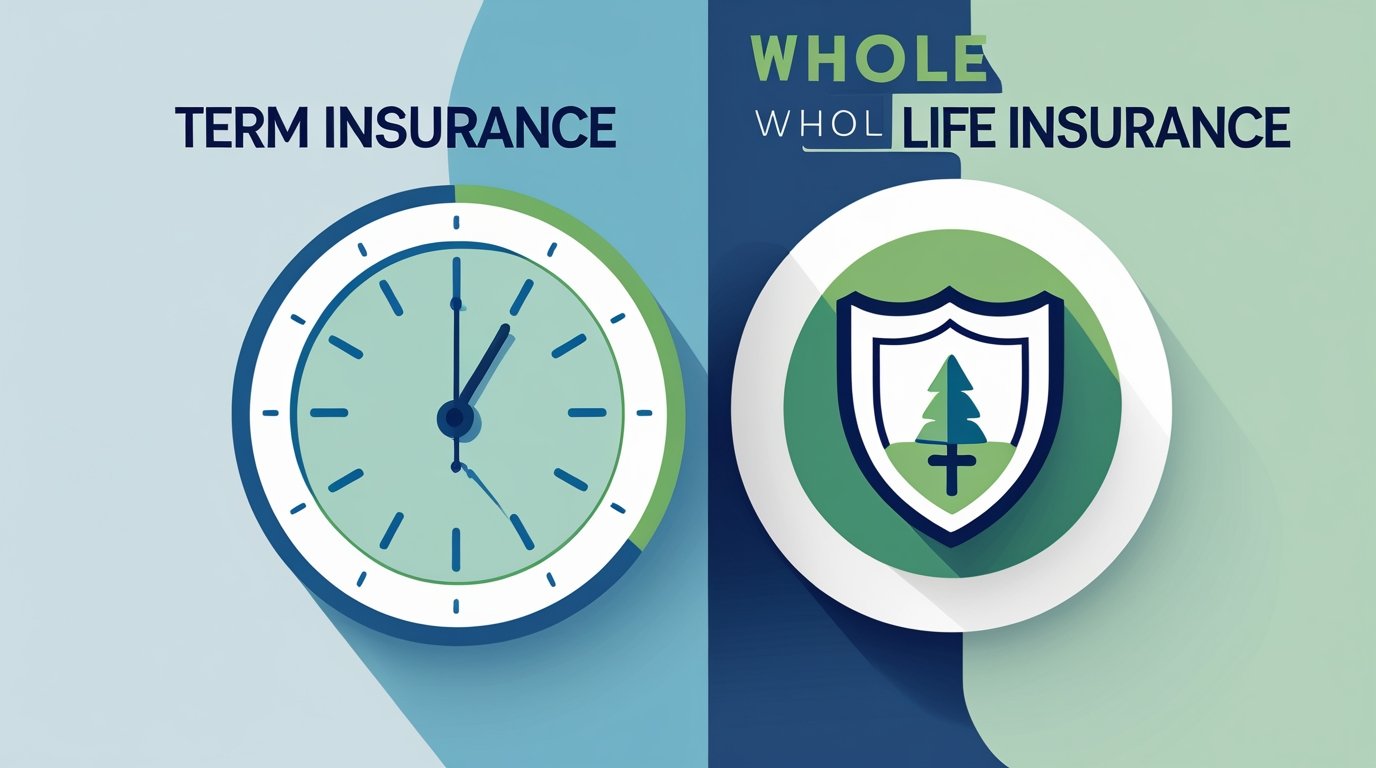Choosing the right life insurance can feel overwhelming, especially when you’re weighing term insurance versus whole life insurance. With rising costs and evolving financial needs in 2025, understanding the differences between these two types of policies is crucial for securing your family’s future. Are you looking for affordable coverage for a specific period, or do you want lifelong protection with added investment benefits? This article breaks down the key differences, benefits, and drawbacks of term insurance and whole life insurance to help you make an informed decision. By the end, you’ll have a clear picture of which policy aligns with your financial goals and lifestyle.
What is Term Insurance?
Term insurance is a straightforward, cost-effective life insurance policy that provides coverage for a specific period, typically 10, 20, or 30 years. If the policyholder passes away during the term, the beneficiary receives a death benefit. If the term expires and the policyholder is still alive, the coverage ends, and no payout is made unless the policy is renewed or converted.
Key Features of Term Insurance
- Affordable Premiums: Term insurance is generally cheaper than whole life insurance, making it ideal for budget-conscious individuals.
- Fixed Term: Coverage lasts for a predefined period, offering flexibility for short-term needs like paying off a mortgage or funding a child’s education.
- No Cash Value: Unlike whole life insurance, term policies do not accumulate savings or investment components.
- Renewable or Convertible: Many policies allow renewal at the end of the term or conversion to a permanent policy without a medical exam.
Who Should Choose Term Insurance?
Term insurance suits individuals who:
- Need coverage for a specific period (e.g., until their children are financially independent).
- Want lower premiums to fit within a tight budget.
- Are young and healthy, as premiums are typically lower for younger applicants.
Example: Sarah, a 35-year-old mother of two, opts for a 20-year term insurance policy with a $500,000 death benefit to ensure her children are supported until they graduate college. Her affordable premiums fit her family’s budget, leaving room for other financial priorities.
What is Whole Life Insurance?
Whole life insurance is a type of permanent life insurance that provides coverage for the policyholder’s entire life, as long as premiums are paid. In addition to a death benefit, whole life policies include a cash value component that grows over time, acting as a savings or investment vehicle.
Key Features of Whole Life Insurance
- Lifelong Coverage: The policy remains active as long as premiums are paid, offering lifelong financial protection.
- Cash Value Growth: A portion of the premium contributes to a cash value account, which grows at a guaranteed rate and can be borrowed against or withdrawn.
- Higher Premiums: Whole life insurance is more expensive due to its lifelong coverage and investment component.
- Dividend Potential: Some policies pay dividends, which can be reinvested, used to reduce premiums, or taken as cash.
Who Should Choose Whole Life Insurance?
Whole life insurance is ideal for those who:
- Want lifelong coverage without worrying about policy expiration.
- Are interested in building a cash value for future financial needs, such as retirement or emergencies.
- Have a higher budget and are comfortable with larger premium payments.
Case Study: John, a 45-year-old business owner, purchases a whole life insurance policy with a $1 million death benefit. Over 20 years, his policy’s cash value grows to $100,000, which he borrows against to fund his daughter’s wedding, while still maintaining coverage for his family.
Term Insurance vs. Whole Life Insurance: A Detailed Comparison
To help you decide, here’s a side-by-side comparison of term insurance and whole life insurance:
| Feature | Term Insurance | Whole Life Insurance |
|---|---|---|
| Coverage Period | Fixed term (e.g., 10, 20, 30 years) | Lifelong, as long as premiums are paid |
| Premium Cost | Lower, affordable | Higher, due to cash value and permanence |
| Cash Value | None | Yes, grows over time |
| Death Benefit | Paid if death occurs during term | Paid upon death, regardless of timing |
| Flexibility | Renewable or convertible options | Fixed, with borrowing options |
| Best For | Temporary needs, budget-conscious | Long-term planning, wealth-building |
Pros and Cons of Term Insurance
Pros:
- Affordable premiums make it accessible for young families or those with limited budgets.
- Simple and easy to understand.
- Ideal for covering specific financial obligations, like a mortgage or education costs.
Cons:
- No payout if you outlive the term.
- No cash value or investment component.
- Premiums may increase significantly upon renewal, especially if health declines.
Pros and Cons of Whole Life Insurance
Pros:
- Lifelong coverage ensures financial security for dependents, regardless of when you pass away.
- Cash value can be used for loans, withdrawals, or supplemental retirement income.
- Potential dividends add financial flexibility.
Cons:
- High premiums can strain budgets.
- Slower cash value growth compared to other investment options.
- Complex structure may require professional guidance to understand fully.
What’s New in 2025 for Life Insurance?
In 2025, the life insurance industry continues to evolve with technology and consumer preferences. Here are some trends impacting term insurance and whole life insurance:
- Digital Underwriting: Insurers now use AI and data analytics for faster, no-medical-exam policies, making term insurance even more accessible.
- Customizable Riders: Both policy types offer new riders, such as critical illness or disability income, enhancing coverage flexibility.
- Sustainability Focus: Some insurers offer “green” whole life policies, where cash value investments support environmentally responsible funds.
- Rising Premiums: Due to inflation and longer life expectancies, premiums for both term and whole life policies may increase slightly in 2025.
Learn more about choosing the right life insurance riders to customize your policy.
For insights into 2025 insurance trends, check out Forbes’ guide to life insurance innovations.
Visual Suggestions
To enhance reader engagement, consider including:
- A comparison infographic of term insurance vs. whole life insurance highlighting costs, coverage, and benefits.
- A video explaining how cash value works in whole life insurance, sourced from a trusted financial education platform like Investopedia.
FAQ Section
What is the main difference between term and whole life insurance?
The primary difference lies in coverage duration and cost. Term insurance covers a specific period (e.g., 20 years) with lower premiums but no cash value. Whole life insurance provides lifelong coverage with higher premiums and a cash value component that grows over time. Choose term if you need affordable, temporary coverage, and whole life for lifelong protection and savings.
Is term insurance cheaper than whole life insurance?
Yes, term insurance is significantly cheaper because it only covers a set period and lacks a cash value component. For example, a 30-year-old might pay $20–$50/month for a $500,000 term policy, while a similar whole life policy could cost $200–$400/month. However, term premiums may increase upon renewal, especially if health declines.
Can I convert term insurance to whole life insurance?
Many term insurance policies offer a conversion rider, allowing you to switch to a whole life insurance policy without a medical exam. This is ideal if your financial situation or goals change. Check with your insurer for conversion deadlines, as they often expire before the term ends.
Does whole life insurance build wealth?
Yes, whole life insurance includes a cash value that grows at a guaranteed rate, typically 2–4% annually. You can borrow against or withdraw this cash for needs like education or retirement. However, returns are lower than other investments like stocks, so it’s primarily a conservative wealth-building tool.
Which is better for young families: term or whole life?
For most young families, term insurance is better due to its affordability and ability to cover key financial obligations, like a mortgage or childcare costs. A 20- or 30-year term policy aligns with the years when dependents need the most support. Whole life insurance may suit families with higher budgets seeking lifelong coverage and savings.
How do I choose the right life insurance policy in 2025?
Assess your financial goals, budget, and coverage needs. If you need temporary, budget-friendly protection, choose term insurance. For lifelong coverage and wealth-building, opt for whole life insurance. Consult a financial advisor and compare quotes from trusted insurers like Northwestern Mutual to find the best fit.
Conclusion
Choosing between term insurance and whole life insurance depends on your financial goals, budget, and life stage. Term insurance offers affordable, temporary coverage, perfect for young families or those with specific financial obligations. Whole life insurance provides lifelong protection and a cash value component, ideal for long-term planning and wealth-building. In 2025, advancements like digital underwriting and customizable riders make both options more accessible than ever. Evaluate your needs, compare quotes, and consult a financial advisor to find the right policy. Have questions or insights about life insurance? Share your thoughts in the comments or sign up for our newsletter for more financial tips!

